|
|
|
|
Products mentioned in this Article
--None--
|
|
|
|
|
|
|
|
|
 |
|
|
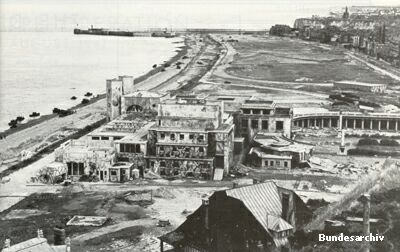 |
The Raid on Dieppe
Dieppe, France, 19 August 1942
The Dieppe raid has gone down in history as a tragic military blunder. The lack of proper intelligence on the German defences and ineffective preparatory bombing and bombardment meant the troops came ashore against withering fire. Despite this the Dieppe raid did have some successes including some epic struggles against extreme odds, which led to some tremendous acts of heroism and bravery. |
|
Above: The beach front at Dieppe, a photo taken just after the raid. The buildings in the forground are the casino which the Germans had fortified.
The Dieppe raid, code named Operation Jubilee, was launched on 19 August after several delays and a cancellation. It was conceived as part of on going raids of different sizes (and was the largest such) along the French coast. These raids aimed to test and reconnoitre the German coastal defences.
The raid was supported by eight destroyers of the Royal Navy and the fighters and bombers of the RAF.
|
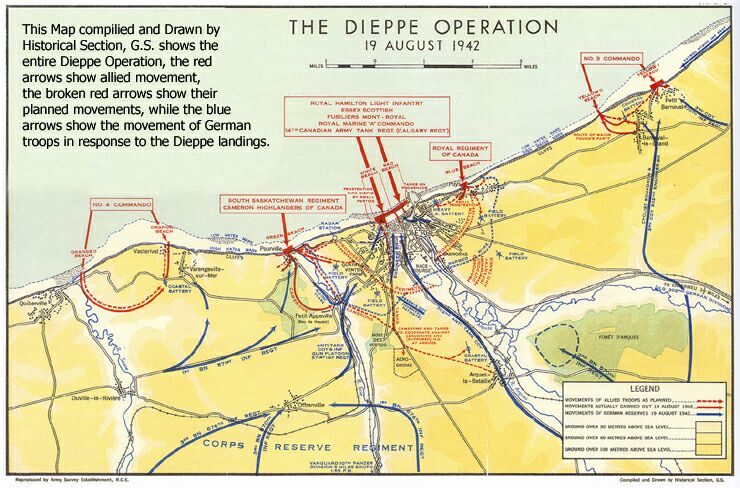 |
|
Most of the troops taking part in the raid were Canadian. The Royal Hamilton Light Infantry, Essex Scottish, Fusiliers Mont-Royal, Royal Regiment of Canada, South Saskatchewan, Cameron Highlanders of Canada regiments and the 14th Canadian Army Tank (Calgary) Regiment all took part in the raid. Also involved were Nos. 3 and 4 Commando of the British Army, the Royal Marine A Commando, 18 inter-allied French Commandos and 50 US Rangers. The total force was just under 5000 strong.
The raid opened with a short bombardment from the 4.5” guns of the Royal Navy Destroyers. It was hoped that by not engaging in a prolonged bombardment and bombing of Dieppe the element of surprise would be retained.
|
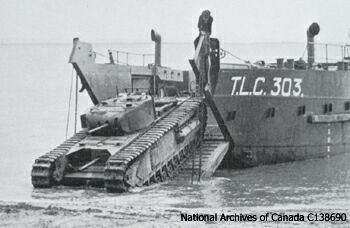 |
|
The RAF was to supply air cover and gain air superiority over Dieppe. Both these assumptions were to prove woefully inadequate.
The destroyers became involved in a short exchange with a German convoy, which alerted the Germans on shore something was a foot, and the bombardment did little in the way of damage to the German positions. On top of this, the RAF fighters did not have enough fuel to stay above Dieppe for any length of time. Therefore both surprise and air cover were limited.
|
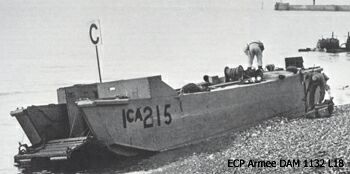 |
The Assaults
The raid wasn’t just an attack on the town of Dieppe. It also included several landings on the flanks. The aims of the raid were to seize and hold the port for a short period, to gather intelligence from prisoners and captured materials, and to test the German reaction. The Allies also wanted to destroy German coastal defences, port structures, and all strategic buildings. Flank attacks were to seize the headlands. To this was added an attack on a German HQ and an airfield further inland.
|
|
Blue Beach
The Royal Regiment of Canada landed at Blue Beach near Puys, but delays meant advantages of surprise and darkness were lost by the time they landed. Sixty German defenders were able to hold the Canadians on the beach. They were joined by several platoons from the Black Watch of Canada, but they weren’t able to free themselves from the beach. The Canadians lost 225 men killed and 264 surrendered on this beach, with only 33 men evacuated back to England.
|
|
Green Beach
On the other side of Dieppe at Pourville (Green Beach) the South Saskatchewan Regiment and the Queen’s Own Cameron Highlanders of Canada landed with few losses. The South Saskatchewans advanced on Dieppe, but they were stopped short of their objective by German defenders, as were Camerons. Both regiments were forced to withdraw and suffering casualties in the process. Landing craft crews managed to evacuate 341 men to the flotilla, leaving the rest to surrender as the Germans closed in on the beach. 141 men were killed. The South Saskatchewan Regiment’s commander, Lieutenant Colonel Charles Cecil Ingersoll Merritt, was awarded the Victoria Cross for his gallantry during the battle, despite being captured along with many of his men.
|
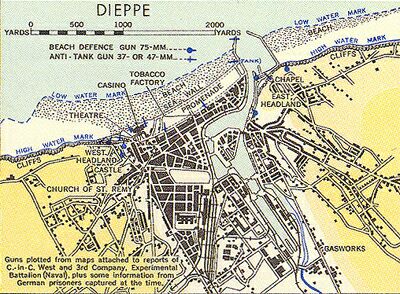 |
| Part of the purpose in landing in Green Beach was to gather intelligence on the German radar station on the cliff-top just to the east of the town of Pourville. RAF Flight Sergeant Jack Nissenthall, a radar specialist who had also completed Commando training, was attached to the South Saskatchewans and assigned to investigate. Strong defence prevented Nissenthall and his Saskatchewan bodyguards from entering the radar station, but he was able to crawl up to the rear of the station under fire and cut the telephone wires leading to it. This forced the German crew inside to use radio to talk to their commanders, allowing the transmissions to be intercepted by listening posts on the south coast of England. The Allies learnt a great deal about the German radar arrays along the channel coast because of this. Nissenthall escaped back to England. |
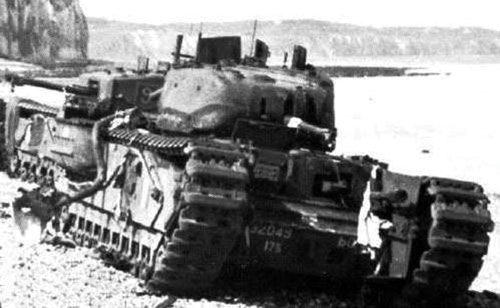 |
Dieppe
Dieppe itself was attacked from three points. The Essex Scottish Regiment landing at the eastern Red Beach, The Royal Hamilton Light Infantry at the western White Beach and 14th Canadian Army Tank Regiment (Calgary Regiment) in the centre. The first units of the Royal Hamilton Light Infantry and Essex Scottish stormed ashore around 0530 hours, 10 to 15 minutes after the bombardment had ceased, more than enough time for the defenders to recover.
|
|
As soon as the Hamilton Light Infantry had landed they came under intense fire from the German defenders. The preliminary bombardment from the destroyers had done little to silence the Germans. The Hamiltons had to withstand the withering fire laid down by the Germans for 15 minutes before the first wave of Churchills arrived. The Hamiltons became pinned down on the beach and were unable to make progress until the landing of reinforcements further down the beach allowed them a respite.
Communications were fragmentary throughout the raid and the reserves were committed to the Dieppe beach at around 0700 hours based on little understanding of the unfolding events. 584 men of Les Fusiliers Mont-Royal took fire during their landing on the beach.
|
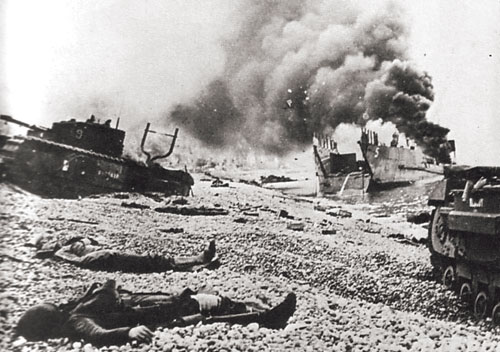 |
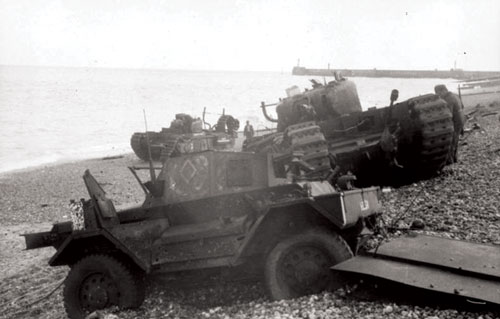 |
The other part of the reserve comprised 369 men of Royal Marine A Commando. They were ordered to White Beach to support if possible. The first of their craft landed under withering machine gun fire. Their commander, Lieutenant Colonel Joseph ‘Tiger’ Phillips, signalled the order to his landing craft to withdraw, but he was hit and killed in the process. However, all but one saw the signal and withdrew, though several craft were already hit. The Commandos that landed could not advanced more than a few yards once ashore.
|
|
At 0720 hours the Hamiltons stormed the fortified casino, with the aid of engineers and small parties of the just landed Fusiliers Mont-Royal, taking out the German guns and positions inside. Several parties then started making their way into the town.
Of the 30 tanks landed in the first wave, only 15 managed to make it off the beach and cross the anti-tank ditch and the seawall onto the promenade between the seawall and the first row of town buildings.
|
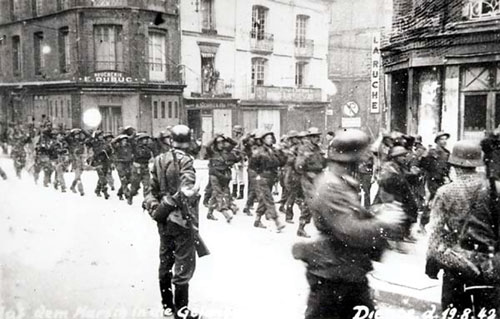 |
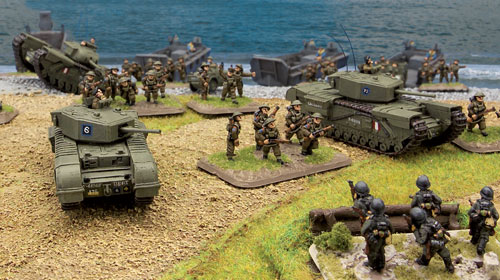 |
The beach at Dieppe was made up of chert, a type of smooth rounded shingle that proved very difficult going for the Churchill tanks. The tanks would slide around or the chert would become lodged in between road wheels and tracks immobilising them or throwing tracks. They came under fire from pillboxes and the guns of flanking cliff-top positions, and they were brought to a complete stop by anti-tank walls blocking the street exits from the promenade. The engineers were unable to clear these obstacles because of heavy fire.
|
|
Fighting continued on the promenade for several hours, but with many troops pinned down on the beach and no further progress made into the town, the order to withdraw was issued at 1050 hours, less that six hours after the first troops had landed. Some Churchill tanks were able to return to the beach to cover the withdrawal.
The landing craft returned to the beaches under smoke and RAF fighter cover. Evacuation took place in confusion with fighting still on going. By 1220 hours, landing craft could no longer make the beaches. The destroyer HMS Calpe made a last evacuation attempt at 1248 hours before the fleet returned to England. The Dieppe raid was over. 3,367 men, including 2,752 Canadians remained on the beaches, dead or as prisoners.
|
|
This Scenario has been specifically devised as for our Dieppe games, and though they can be used with other forces they are in no way intended for tournament play.
Scenario ~ Amphibious Assault
The landing of the Hamilton Light Infantry
The air attack began at 5.10am, quickly followed by the first landings. The first Canadians hit the beach at 5.23am, they faced a hail of fire from the fortified German positions. The Germans had reinforced all the hotels and houses along the promenade and the Casino at the western end of the beach had been camouflaged and fortified as a strongpoint.
Between the beach and the promenade ran the sea wall, this was up to ten feet high in places and was lined with barbed wire. There was also a shallow trench that ran along the Chert beach that had been formed by the action of the waves and tides. German excavations for building works had further deepened this.
Special Rules
Ambush (Defender), Immediate Reserves (Defender).
Chert special rule (Both): The Chert Beach at Dieppe requires a Cross test, and Tank teams crossing it must re-roll successful Cross tests.
Amphibious Landing special rule (Attacker): First position your landcraft on the beach edge, then roll a die for each landing craft. Roll a die for each LC and drift it 2" down current for each pip. The current is moving left to right from the Canadian side of the battlefield. Each landing craft must make a 4+ die roll to land on the beach, if they pass Infantry and Vehicles exit during the movement step from the front of the landing craft. Vehicles take bogging tests for Chert special rule.
If the landing craft fails its skill test it has not landed properly, all it passenger must now make a skill test to come ashore. Passed skill tests allow infantry teams and vehicles to come ashore as above. Failed skill tests means infantry teams are stuck aboard the Landing Craft until their next turn when they can take another skill test to get off. Vehicles that fail their skill test are drowned and count as destroyed.
Infantry still aboard beached LCA landing craft can be shot at. Troops on an LCA get a special 3+ save if they fail their infantry save.
|
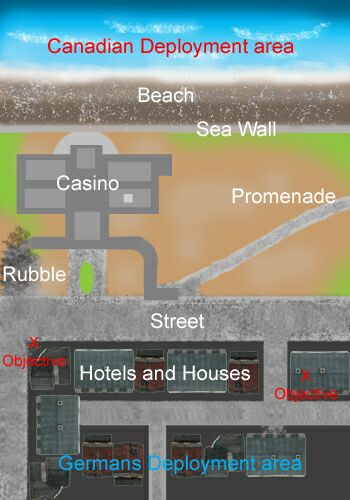 |
Situation Report
Canadians
Your mission is to penetrate Dieppe town, over coming German resistance with the aid of the Churchills. German resistance is stiff.
Germans
The British have landed, you are unsure if this is the start of something big, they are supported by heavy tanks and have air support.
Your Orders
Canadians
You must seize one of the objectives before the Germans have time to gather their reserves and stop you.
Germans
You must stop the British from leaving the beach (their half of the table), this invasion must be stopped in it tracks.
Setting Up
The attacker, defender, objectives and table edges are set. See game map.
|
|
Deployment
The German Defender places the required part of their force in Immediate Reserve and may hold one Unit in Ambush. Reserves arrive from the Defender's short table edge. The remaining German Units are deployed in their half of the table. German Units can be deployed up to the front of the Casino 48"/120cm from their table edge.
Next the Canadian deploys their LCA landing craft along the beach edge. The TLC landing craft are not deployed until the following turn and appear along the beach edge.
The Canadians have the first turn.
German units and teams start the game Pinned Down and Bailed Out.
Winning the Game
The Canadian Attacker wins if they end their turn Holding an Objective. The German Defender wins if they end their turn on or after the sixth turn with no Attacking Tank, Infantry or Gun teams within 8"/20cm of an Objective.
|
|
Forces
Canadians
The Royal Hamilton Light Infantry ~ Rifle Company, page 57 Armoured Fist
Rifle Company HQ (MB133)
2x SMLE rifle team |
2 points |
Rifle Platoon (MB134)
1x LCA landing craft
7x Bren Gun & SMLE rifle team
1x Boys anti-tank rifle
1x 2-inch mortar
|
11 points |
Rifle Platoon (MB134)
1x LCA landing craft
7x Bren Gun & SMLE rifle team
1x Boys anti-tank rifle
1x 2-inch mortar |
11 points |
Rifle Platoon (MB134)
1x LCA landing craft
7x Bren Gun & SMLE rifle team
1x Boys anti-tank rifle
1x 2-inch mortar |
11 points |
3-inch Mortar Platoon (MB135)
1x LCA landing craft
6x 3-inch mortar
|
9 points |
Vickers MMG Platoon
1x LCA landing craft
4x Vickers MMG |
4 points |
14th Canadian Army Tank Regiment
Churchill III Armoured Troop (MB130)
3x Churchill (6 pdr)
1x TLC landing craft |
33 points |
Churchill Armoured Troop
1x Churchill (6 pdr)
1x Churchill (CS)
1x Churchil (2 pdr)
1x TLC landing craft |
32 points |
|
Germans
571st Infantry regiment ~ Grenadier Company page 35 Iron Cross
|
Grenadier Company HQ (MG215)
2x MP40 SMG team
|
2 points |
Grenadier Platoon (MG216)
7x MG34 and K98 rifle team |
9 points |
Grenadier Platoon (MG216)
7x MG34 and K98 rifle team |
9 points |
Grenadier Platoon (MG216)
7x MG34 and K98 rifle team |
9 points |
3.7cm Tank-hunter Platoon (MG225)
4x 3.7cm (Stielgranate) gun |
12 points |
3.7cm Tank-hunter Platoon (MG225)
4x 3.7cm (Stielgranate) gun |
12 points |
8cm Mortar Platoon
4x 8cm mortar |
6 points |
sMG34 Machine-gun Platoon
4x sMG34 HMG |
6 points |
Coastal Defence Guns
(7.5cm Infantry Gun Platoon, MG213)
3x 7.5cm infantry gun |
16 points |
Naval Troops
Krieg Marine Platoon
Grenadier Platoon (MG216)
7x MG34 and K98 rifle team
|
9 points |
|
|
To field the Churchill Armoured Troop's Churchill (CS) and Churchill (2 pdr) use the Churchill II Armoured Squadron HQ, but field the Churchill (2 pdr) using the Churchill (CS), without the 3-inch gun.
|
|
What Happened ~ The History
As soon as the Hamilton Light Infantry had landed they came under intense fire from the German defenders. The preliminary bombardment of the destroyers had done little to silence the Germans. The Hamiltons had to withstand the withering fire laid down by the Germans for 15 minutes before the first wave of Churchills arrived.
The Hamiltons became pinned down on the beach and were unable to make progress until the landing of reinforcement further down the beach allowed them a respite. At that point they stormed the fortified casino, with the aid of Engineers and small parties of the just landed Fusiliers Mont-Royal, taking out the Germen guns and positions inside.
This was at 7.20am. Several parties then started making their way into the town. Some of the Churchills became bogged down on the beach; some supported the storming of the casino while others fired on the German positions in the town and on the cliffs.
Related Articles
Mid War Commando Models...
No. 3 Commando at Berneval, Dieppe Raid...
No. 4 Commando at Varengeville, Dieppe Raid...
Dieppe Forces in Flames Of War...
Churchill Oke...
|
Last Updated On Monday, January 10, 2022 by Wayne at Battlefront
|
|
|